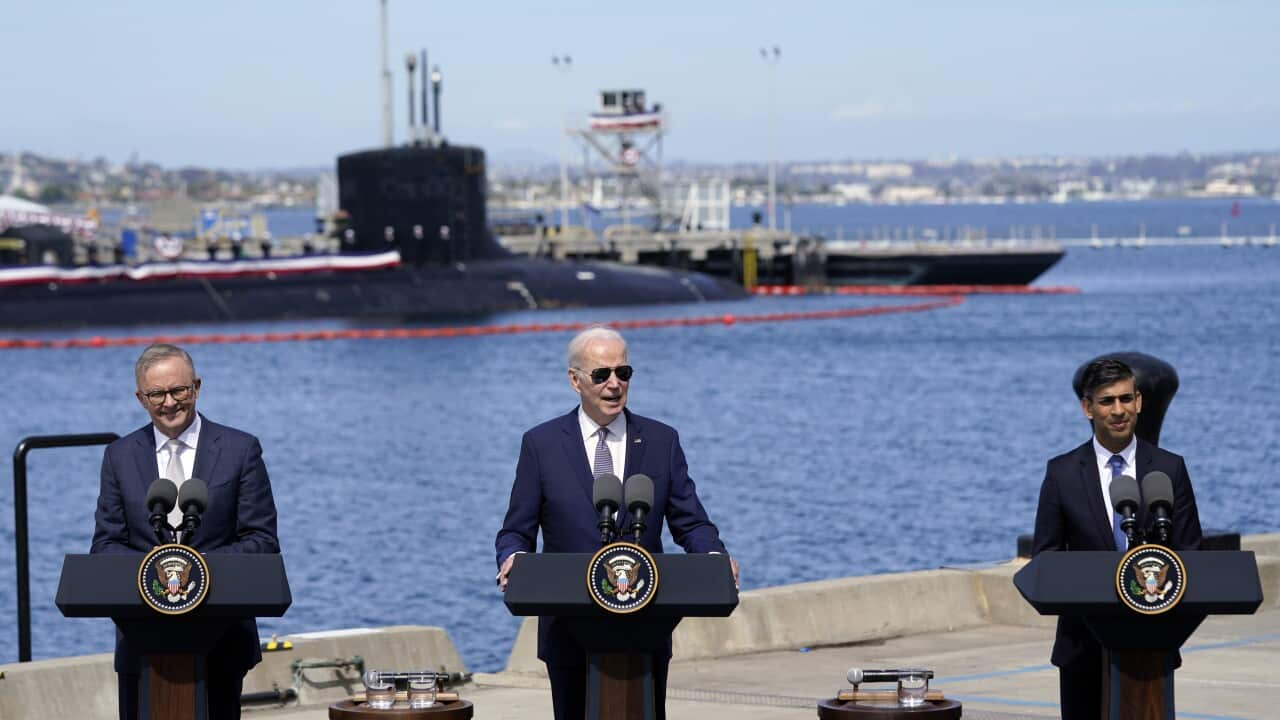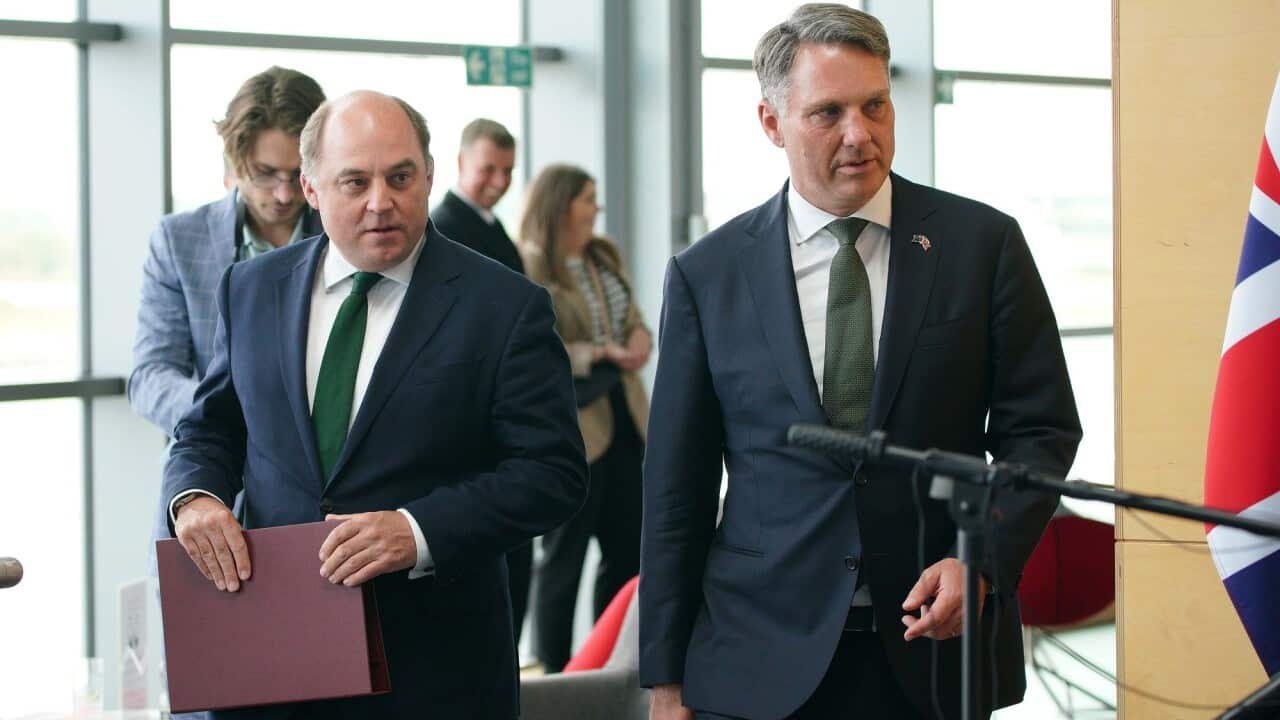Key Points
- The biggest ace in Australia's defence arsenal has beeen unveiled.
- Prime Minister Anthony Albanese has outlined the terms of a nuclear submarines deal with the US and UK.
- Defence Minister Richard Marles said it would be one of Australia's greatest projects.
Within four years Australia will be hosting “rotational deployments” of US and UK submarines in Perth, as part of one of the most ambitious defence undertakings in the nation’s history responding to the intensifying undersea arms contest with Beijing in the Indo-Pacific.
Alongside US President Joe Biden and UK Prime Minister Rishi Sunak in San Diego on Tuesday Australian time, Prime Minister Anthony Albanese unveiled the first project under the AUKUS agreement, with Australia set to produce its first locally-built boat in 20 years.
The program is expected to cost Australian taxpayers between $268 billion and $368 billion by the mid-2050s. That figure includes an estimate of the construction and sustainment of the boats and all associated costs, including investing in capability in the US and UK.
Up to eight new Australian-made AUKUS class conventionally armed but nuclear-powered submarines will roll off the production line from the early 2040s.
They will be equipped with the US vertical launch system. It’s envisaged one would be produced every three years.

The submarines are intended to act as a deterrent to threats in the region. Source: AAP / SOPA Images/Sipa USA
'Shared tradition'
The three leaders announced the deal against a backdrop of nuclear submarines and sailors in a very public and pointed joint show of military strength at the naval base in San Diego, to send a message aimed directly at Beijing about the security environment to come.
Mr Albanese said the partnership was about strengthening national security and stability in the region.
"For more than a century, brave citizens from our three countries have been part of a shared tradition of service in the cause of peace and sacrifice in the name of freedom," he said.
"While we respect and honour the past, through AUKUS, we turn ourselves to face the future."
Mr Biden said the agreement was a testament to the strong ties between the three nations.
"As we stand at the inflection point in history ... the United States can ask for no better partners in the Indo-Pacific, where so much of our shared future will be written," he said.
The Australian government is going to great pains to explain how the nuclear technology will be safeguarded so it doesn’t breach our nuclear non-proliferation arrangements.
Submarines are not nuclear-armed
Mr Biden repeatedly stressed the deal did not pave the way for Australia to have "nuclear weapons of any kind", saying the three countries remained "deeply committed" to strengthening nuclear non-proliferation.
"I want to be clear to everyone from the outset, right off the bat, so there’s no confusion or misunderstanding on this critical point: These subs are powered — not nuclear-armed subs. They’re nuclear-powered, not nuclear-armed," he said.
"Australia is a proud non-nuclear weapons state and has committed to stay that way."
Australia is also committing to store the spent fuel waste eventually created on an Australian defence-owned site to be chosen this year.
In the meantime, the Collins class diesel-powered submarines will continue to operate, and Australia will send increased numbers of submariners to the United States.
It’s already got a handful in training, but will need to recruit at least 1,000 people to receive the high-level training required to operate the submarines.
The SSN-AUKUS is the submarine that will bring together technology from all three nations, what one publication described as the “franken-sub”, will have a British next-generation design, as well as key technology from the US.
The first step will be sending more US and UK nuclear submarines on rotation to Australia while attracting a workforce to learn to use the boats domestically.
That increase in activity will start next year and by 2027 Perth will host a “rotational presence” of UK Astute class and US Virginia Class submariners.
The US already has rotations of marines coming through the Northern Territory at increasing frequency.
Then Australia will await the approval of Congress before buying three US Virginia Class submarines, with the state of the Collins class fleet to determine whether a further two are also purchased.
After that the UK will start building up its capacity to build this new AUKUS class boat, producing its first off the production line for the UK’s Royal Navy in the late 2030s.
Australia will get its first Australian-made nuclear-powered submarine in about 20 years.
'Incredibly historic'
US ambassador to Australia Caroline Kennedy described Tuesday’s announcement as “incredibly historic” for Canberra, given it will include Washington sharing its most sensitive technology.
“It's historic for the United States, as well, because Australia is emerging as such a significant ally,” she said.
“It always has been, but I think this is really going to take it to another level. And Australia's contributing to the US, training with the US, so I think that the partnership is just going to get closer and closer.”
While Australia is politically focused on the submarine deal, it’s barely made headlines in the United States over recent days with reporting focused on the collapse of Silicon Valley Bank and moves by the government to ensure depositors can get their money back.
The Collins class submarines will undergo works worth up to $6 billion to extend the life of the fleet until the AUKUS class Australia-made boats are being produced in the 2040s.











